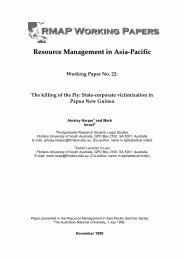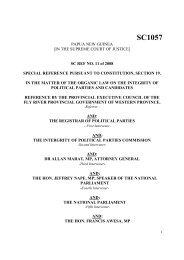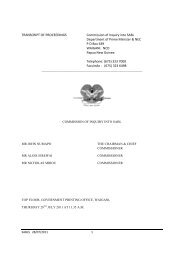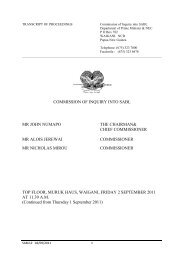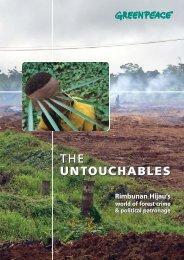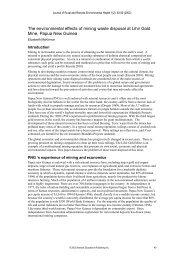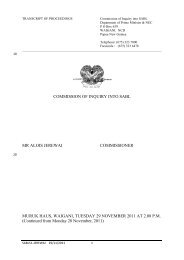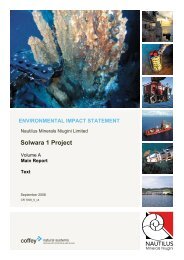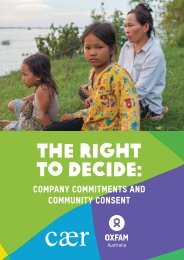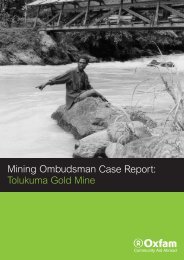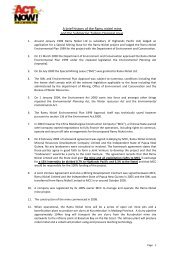Fishy business. The Social Impact of SST.pdf - Act Now!
Fishy business. The Social Impact of SST.pdf - Act Now!
Fishy business. The Social Impact of SST.pdf - Act Now!
Create successful ePaper yourself
Turn your PDF publications into a flip-book with our unique Google optimized e-Paper software.
and pay K2 to come in the morning and K2 to go back home in the afternoon. If they pay K4per day for transport times by 10 working days equals K40 per week for transport that’sbasically their pay that is all spent on transport. Some people come as far Passam and EastCoast about 8 km away. <strong>The</strong>y are happy to work but very poor condition.<strong>The</strong> East Sepik Provincial government does have a share in the factory. I don’t know the actualpercentage <strong>of</strong> it. <strong>The</strong> plan now is to open a trust account for the province so any dividends fromprojects the Provincial Government has shares will be deposited into the account. With thecurrent uncertainly in the provincial administration starting from the governor and theadministration I don’t know where that issue is at.Prostitution – yes there is possibilities but we don’t know yet. Inside the cannery among theemployees I couldn’t tell from the outside. But for the Asian fishermen and crews it is possible.<strong>The</strong>re are lots <strong>of</strong> stories about fish exchange out on the boats. It is possible for women to sellthemselves in exchange for cash or other favors and food items. Though I don’t have hard factsto confirm my allegation but I don’t rule this out. Only time and proper investigation like thissure will bring to light the truth in the story.Fishing- the fishing vessels are only after the tuna. <strong>The</strong> main fish they catch is skipjack tuna,and they also catch yellow fin tuna. <strong>The</strong>y use the net that stretch out 100 to 115 kilometers inthe open sea and whatever is in that range are netted and dumped into their freezers. Other fishapart from tuna are called by-catch which are useless to them so they dump them back into thesea. By-catch can be anything from sharks, dolphins and whatever fish within the range <strong>of</strong> theirnet. <strong>The</strong>y may also send them overseas but if local companies are contracted to collect them andsell to local consumption here would be better than to dump them into the sea.Ownership <strong>of</strong> <strong>SST</strong>C – What I know is that it is an American company owned by Heinz. <strong>The</strong>yalso own the Star Kiss Tuna and another big fishing company. What they do here is contractingthe South Korean to loin fish here and supplies their factories Hawaii, San Francisco and Portde Rigo. That is what I heard from some sources in the provincial government. <strong>The</strong>y also haveconnection with ANGCO through Thomas Nigkins. Why it is called South Seas – Star Kiss andAngco combine to give this name.Benefits <strong>of</strong> <strong>SST</strong>C-- employments for the 1200 employees- Guard Dog Security came to reduce crime problems in Weak by doing foot patrolespecially at night- Other indirect benefit to the markets and other service providers.According to the project <strong>of</strong>ficer the land where the loining factory is built is recognized as astate land. However, the people <strong>of</strong> Kreer and Meni both claim that they are the traditionalowners <strong>of</strong> the land and were consulted prior to the erection <strong>of</strong> the factory. <strong>The</strong>se two groups stillhave conflict over who should be recognised as the traditional owner <strong>of</strong> the land where theloinery is now. He pointed out that to avoid land related problems the government will have touse the state owned land. Unfortunately, state owned land is very limited and for any projectdevelopment by inviting foreign companies in is bit <strong>of</strong> a problem. Even land that are recognizedby the government as state owned has land related problems when trying to establishdevelopment projects such as the loinery. With that particular land the two groups (Meni andKreer) are in conflict as to who is rightfully the traditional owner <strong>of</strong> the land. While there isconflict amongst the locals the second party they have conflict with is the Government/State.<strong>The</strong>se issues are yet to be solved. According to the East Sepik Provincial Government the State132



